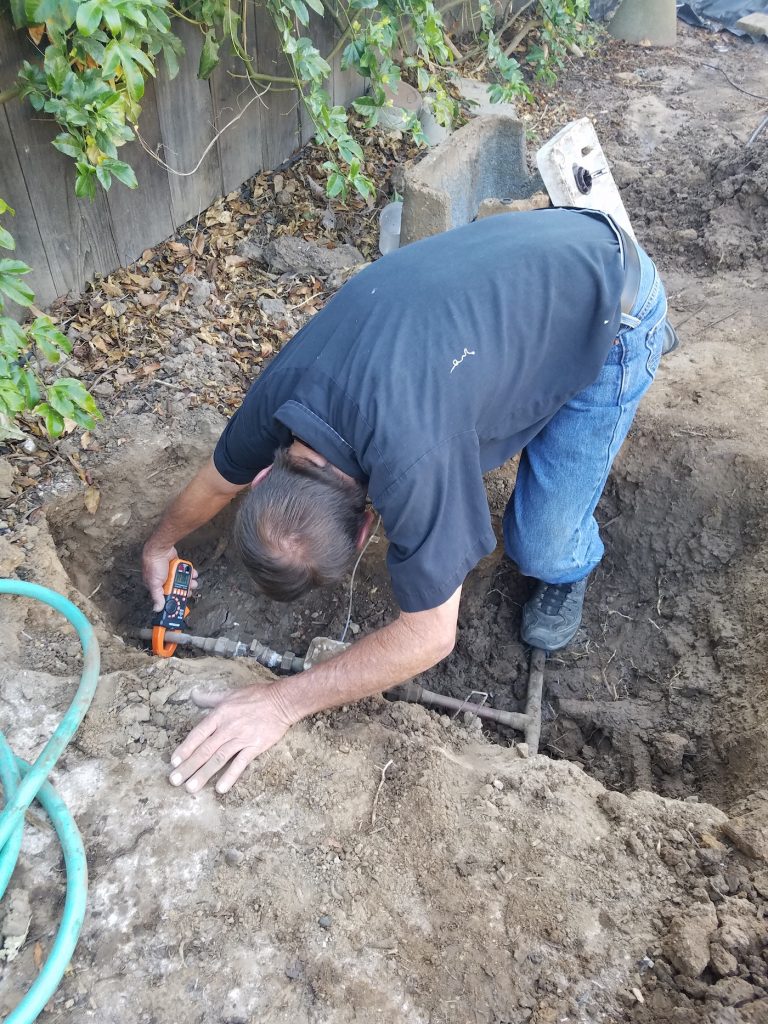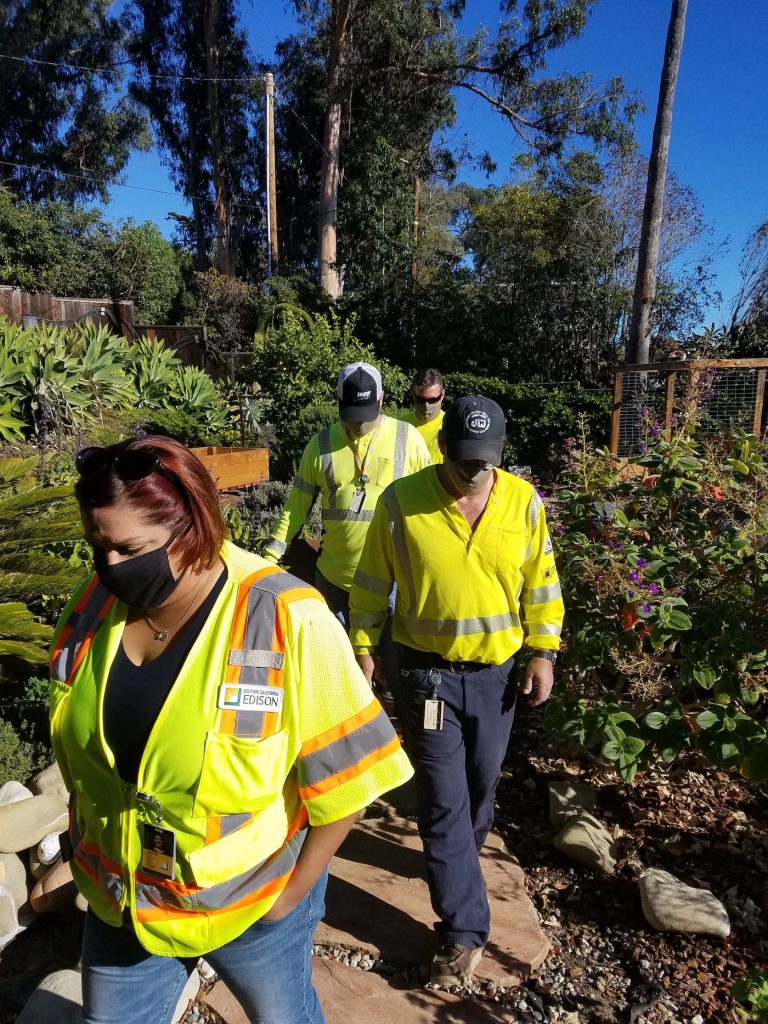Watt’s Going On With Trevor Broudy’s Water Supply?

Trevor Broudy could be forgiven for thinking he might just be the unluckiest person in Montecito. The Middle Road homeowner’s troubles began early last year, when Bacall, his beloved golden retriever, began to rapidly and inexplicably lose weight. Aside from taking his pet to various veterinarians, Broudy stopped giving Bacall tap water to drink and switched to bottled water; the dog slowly but surely began to recover.
The mystery deepened when Broudy received a telephone call from the Montecito Water District (MWD) in September letting him know that the agency had detected unusually high levels of copper in his home’s drinking water. As he soon learned, MWD does periodic tests of end-user water quality to ensure that both copper and lead levels in the drinking water stay below state-mandated action guidelines. Earlier readings had found copper levels of just 90 parts per billion (ppb) in his drinking water, but mysteriously, a recent test showed that number had somehow jumped exponentially to 1500 ppb.
“I was up in Lake Tahoe and got a call [from MWD] saying that my water was so high in copper that it was way above the [safe] threshold,” Broudy recalled. “They had never seen copper levels like this in Montecito and thought it might be a mistake.” Broudy says he couldn’t believe his ears. He had just installed new copper pipes in his home two years ago at a cost of $40,000. “But they came back three weeks later and told me that it wasn’t a mistake.”
Broudy says he asked MWD what he should do but didn’t receive any initial guidance so he went on Google and searched for articles about copper contamination in drinking water and found stories about just such a situation that occurred a few years ago in New York state, where water pipes had been inadvertently exposed to an electrical current by the local power company, thus resulting in electrolysis, which caused unhealthy levels of the mineral to leach into drinking water.
Armed with his internet-fueled suspicions, Broudy used a Gauss meter to test the electromagnetic field on one of his copper pipes; the test suggested a stray electrical current was somehow connected to his plumbing. So he called an electrician to his home and asked him to investigate. On November 10, Carlton Electric conducted a series of tests and tried to figure out how to remove the current, but to no avail; the company suggested he contact Southern California Gas Company and Southern California Edison (SCE) for advice on what to do.
According to Broudy, SoCal Gas came out the following day, and after finding 45 volts of electricity on his gas meter, 18 volts on the gas line, and 8 volts on several kitchen appliances, advised him not to touch the gas meter or any appliances inside his house. “I was advised to leave the house immediately as the current posed an electrocution hazard,” he says.
Testing, Testing

At 6 pm that evening, Southern California Edison arrived with two work crews and did several tests on his home and several others on his street but left several hours later without determining a cause for the problem. The next day, Broudy says an SCE worker told him that the stray current was coming from a Cox Communication pedestal device on Middle Road. SCE then performed a so-called “hazard cut” on the cable company’s equipment, which forced Cox to set up a temporary generator to keep cable service in the neighborhood working.
Cox removed the generator a week later, at which time Broudy says he spoke with a company representative who stated that a coaxial cable that was connected to a grounding rod had created a back field of current going to his house, but that Cox had replaced and repositioned the cable, which should fix the problem. However, Broudy’s Gauss meter still registered an electrical current on his pipes, so he called SCE again and on November 25, the company returned to his property to do more tests.
This time, SCE cut off the utility’s electrical connection to Broudy’s roof and then tested his copper pipes to see if there was still a problem. Although the amperage readings were much lower than before, a small current was still running through his plumbing, demonstrating, according to the SCE worker, that, while Cox may not have entirely fixed the problem, there was no longer any electrocution hazard in his home.
Five days later, on November 30, Broudy received a call from Cox saying they had fixed the problem on their end and any stray current in his plumbing was something that SCE would have to address. Broudy also paid for a plumber to replace part of his plumbing with plastic piping in order to ensure that no current would be able to continue reaching inside his house.
But the copper levels in his water didn’t go away. Two subsequent MWD tests of the water flowing from Broudy’s kitchen sink in December 2020 came back showing that the copper levels in his water were still abnormally high. “It was at almost 3000 parts per billion,” Broudy recalled. “This time, instead of testing the water in the morning, they tested it midday when the water had already been flowing through the pipes for a while, and the results were three times over the maximum allowable levels.”
Calling All Agencies
Feeling insecure in his own house, Broudy split town and on Christmas Day briefly retreated with Bacall to Lake Tahoe. But meanwhile, his story spread like wildfire via the neighborhood watch app Nextdoor.com, resulting in a written appeal for First District Supervisor Das Williams to help facilitate an official response. As a result of the hub-bub all three agencies involved in the mystery – MWD, SCE, and Cox – are now looking into what happened. So the Montecito Journal reached out to all three entities asking for answers.

MWD confirmed that it initiated extensive intensive tests of other homes near Broudy’s, in the hopes of finding whether what happened to his pipes is an isolated case or a more widespread problem. The agency’s executive director, Nick Turner, said that work was still ongoing. “We have expanded our investigation outside of his house in order to ensure the public that this isn’t more widespread than originally thought,” Turner said. “We’re in the midst of that process, but we don’t have any additional information to share, nor have we come to any conclusions yet. We hope to have some more conclusive data soon.”
According to Turner, MWD has been required by law to conduct tests for both copper and lead every three years since the 1990s. “The program is primarily focused on lead, but copper is monitored alongside it,” he explained. “If there is anybody above the state limit, we contact them and let them know and try to help them determine what the source of the higher level is within their piping, but it’s pretty rare to have people above the action limit. That program is ultimately what led to an elevated reading of copper levels at his residence and because of our concern that this particular problem could exist elsewhere, we have unofficially expanded our program, going above and beyond state requirements, to test both locally and district-wide.
Turner refused to say exactly how many other homes have been tested since high copper levels were discovered in Broudy’s water, nor would he offer any specific explanation for why the problem might have occurred. “From our perspective, that data is private,” he said. “There are a lot of ways copper can leach into water,” he added, however. “The water can be corrosive in nature, and corrode the pipes, but our water is on the non-corrosive side of the scale,” he offered. “It can also happen to people with their own private water treatment systems, but for those people who don’t have their own systems and are just using district water, there is the possibility of copper electrolysis resulting in copper leaching out of the pipe into the water.”
SCE spokesperson David Song said his agency is also still investigating. “Obviously nothing is more important to us than the safety of our customers and community,” he said. “We will continue to work diligently with Mr. Broudy and the other utilities, but we can’t speculate until we’ve gone through our research and analysis.”
Charla Batey, a spokesperson for Cox Communications, also confirmed her agency is monitoring the situation, “We’ve been working with MWD and Edison and Supervisor Williams,” she said. “We inspected our equipment a few times and there is no current between our lines and his. We haven’t heard any complaints from other customers on Middle Road, or elsewhere in Montecito.”
For his part, Broudy says his main concern at this point is getting a straight answer about what caused the problem with his water, and whether or not the same problem is affecting any of his neighbors. “I really don’t want the attention that this story has brought,” he said. “I just want to make sure this issue doesn’t affect other people or animals.”
Stay tuned for additional updates on this story as it develops.







You must be logged in to post a comment.